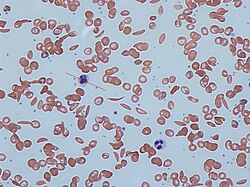Hemoglobinopathy
Editor-In-Chief: Prab R Tumpati, MD
Obesity, Sleep & Internal medicine
Founder, WikiMD Wellnesspedia &
W8MD medical weight loss NYC and sleep center NYC
| Hemoglobinopathy | |
|---|---|

| |
| Synonyms | N/A |
| Pronounce | N/A |
| Specialty | N/A |
| Symptoms | Anemia, fatigue, jaundice, pain crisis |
| Complications | Stroke, acute chest syndrome, organ damage |
| Onset | Varies by type, often in childhood |
| Duration | Chronic |
| Types | Sickle cell disease, thalassemia, hemoglobin C disease, hemoglobin E disease |
| Causes | Genetic mutation in hemoglobin genes |
| Risks | Family history, ethnic background |
| Diagnosis | Blood test, genetic testing |
| Differential diagnosis | N/A |
| Prevention | N/A |
| Treatment | Blood transfusion, hydroxyurea, bone marrow transplant |
| Medication | N/A |
| Prognosis | N/A |
| Frequency | Common in certain populations, such as those of African, Mediterranean, Middle Eastern, and Southeast Asian descent |
| Deaths | N/A |
Hemoglobinopathy is a kind of genetic defect that results in abnormal structure of one of the globin chains of the hemoglobin molecule. Hemoglobinopathies are inherited single-gene disorders; in most cases, they are inherited as autosomal co-dominant traits.
Introduction
Hemoglobinopathies are often considered as a group, including thalassemia and sickle cell disease. They are common genetic disorders in the world, particularly in people of African, Mediterranean, and Southeast Asian ancestry.
Types of Hemoglobinopathy
There are many types of hemoglobinopathy, the most common of which are:
- Beta thalassemia - This is caused by reduced (beta+) or absent (beta0) synthesis of the beta globin chains of hemoglobin.
- Alpha thalassemia - This is caused by reduced (alpha+) or absent (alpha0) synthesis of the alpha globin chains of hemoglobin.
- Sickle cell disease - This is caused by a mutation in the HBB gene on chromosome 11. It is inherited in an autosomal recessive manner.
Symptoms
The symptoms of hemoglobinopathy can vary greatly depending on the specific type of disorder. Some people may have no symptoms or mild anemia, while others may have severe symptoms. Common symptoms can include:
- Fatigue and weakness
- Pale or yellowish skin
- Abdominal pain
- Dark urine
- Delayed growth and development in children
- Shortness of breath
Diagnosis
Hemoglobinopathies are diagnosed through blood tests that look for abnormal hemoglobin molecules. These tests can include:
- Complete blood count (CBC)
- Hemoglobin electrophoresis
- Genetic testing
Treatment
Treatment for hemoglobinopathies is aimed at managing symptoms and avoiding complications. This can include:
- Regular blood transfusions
- Medications to reduce pain and prevent complications
- Bone marrow transplant
See Also
References
Transform your life with W8MD's budget GLP-1 injections from $125.
W8MD offers a medical weight loss program to lose weight in Philadelphia. Our physician-supervised medical weight loss provides:
- Most insurances accepted or discounted self-pay rates. We will obtain insurance prior authorizations if needed.
- Generic GLP1 weight loss injections from $125 for the starting dose.
- Also offer prescription weight loss medications including Phentermine, Qsymia, Diethylpropion, Contrave etc.
NYC weight loss doctor appointments
Start your NYC weight loss journey today at our NYC medical weight loss and Philadelphia medical weight loss clinics.
- Call 718-946-5500 to lose weight in NYC or for medical weight loss in Philadelphia 215-676-2334.
- Tags:NYC medical weight loss, Philadelphia lose weight Zepbound NYC, Budget GLP1 weight loss injections, Wegovy Philadelphia, Wegovy NYC, Philadelphia medical weight loss, Brookly weight loss and Wegovy NYC
|
WikiMD's Wellness Encyclopedia |
| Let Food Be Thy Medicine Medicine Thy Food - Hippocrates |
Medical Disclaimer: WikiMD is not a substitute for professional medical advice. The information on WikiMD is provided as an information resource only, may be incorrect, outdated or misleading, and is not to be used or relied on for any diagnostic or treatment purposes. Please consult your health care provider before making any healthcare decisions or for guidance about a specific medical condition. WikiMD expressly disclaims responsibility, and shall have no liability, for any damages, loss, injury, or liability whatsoever suffered as a result of your reliance on the information contained in this site. By visiting this site you agree to the foregoing terms and conditions, which may from time to time be changed or supplemented by WikiMD. If you do not agree to the foregoing terms and conditions, you should not enter or use this site. See full disclaimer.
Credits:Most images are courtesy of Wikimedia commons, and templates, categories Wikipedia, licensed under CC BY SA or similar.
Translate this page: - East Asian
中文,
日本,
한국어,
South Asian
हिन्दी,
தமிழ்,
తెలుగు,
Urdu,
ಕನ್ನಡ,
Southeast Asian
Indonesian,
Vietnamese,
Thai,
မြန်မာဘာသာ,
বাংলা
European
español,
Deutsch,
français,
Greek,
português do Brasil,
polski,
română,
русский,
Nederlands,
norsk,
svenska,
suomi,
Italian
Middle Eastern & African
عربى,
Turkish,
Persian,
Hebrew,
Afrikaans,
isiZulu,
Kiswahili,
Other
Bulgarian,
Hungarian,
Czech,
Swedish,
മലയാളം,
मराठी,
ਪੰਜਾਬੀ,
ગુજરાતી,
Portuguese,
Ukrainian
Contributors: Prab R. Tumpati, MD




